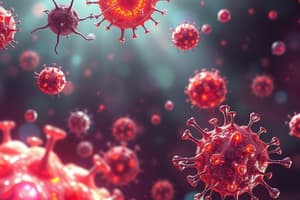Podcast
Questions and Answers
What is required for the activation of CD8+ T cells?
What is required for the activation of CD8+ T cells?
- Recognition of class I MHC-associated peptides only
- Recognition of class I MHC-associated peptides and costimulation (correct)
- Recognition of class II MHC-associated peptides and helper T cells
- Recognition of class II MHC-associated peptides and costimulation
What is required for the differentiation of naive CD8+ T cells into fully active cytotoxic T lymphocytes (CTLs) and memory cells?
What is required for the differentiation of naive CD8+ T cells into fully active cytotoxic T lymphocytes (CTLs) and memory cells?
- Concomitant activation of B cells
- Concomitant activation of natural killer cells
- Concomitant activation of CD4+ helper T cells (correct)
- Concomitant activation of CD8+ cytotoxic T cells
What happens within minutes of antigen recognition in activated T cells?
What happens within minutes of antigen recognition in activated T cells?
- Only new gene transcription is seen without protein synthesis
- No changes in gene transcription or protein synthesis are seen
- New gene transcription and protein synthesis are seen (correct)
- Only protein synthesis is seen without new gene transcription
Which of the following is not a consequence of signal transduction pathways emanating from the TCR complex and costimulatory receptors?
Which of the following is not a consequence of signal transduction pathways emanating from the TCR complex and costimulatory receptors?
Which of the following is not one of the biochemical pathways of T cell activation described in the text?
Which of the following is not one of the biochemical pathways of T cell activation described in the text?
What is the main difference between the response pathways of CD4+ and CD8+ T lymphocytes described in the text?
What is the main difference between the response pathways of CD4+ and CD8+ T lymphocytes described in the text?
What is the primary function of CTLA-4 in T cell activation?
What is the primary function of CTLA-4 in T cell activation?
Which of the following is the correct order of events in the NFAT pathway?
Which of the following is the correct order of events in the NFAT pathway?
What is the primary role of the Ras/Rac-MAP kinase pathways in T cell activation?
What is the primary role of the Ras/Rac-MAP kinase pathways in T cell activation?
Which of the following molecules is directly involved in the initiation of the NFAT pathway?
Which of the following molecules is directly involved in the initiation of the NFAT pathway?
What is the primary role of the CD3 and ζ chains in T cell activation?
What is the primary role of the CD3 and ζ chains in T cell activation?
What is the primary function of the enzyme calcineurin in the NFAT pathway?
What is the primary function of the enzyme calcineurin in the NFAT pathway?
Flashcards are hidden until you start studying
Study Notes
Stimuli for Activation of CD8+ T Cells
- Recognition of class I MHC-associated peptides stimulates CD8+ T cell activation
- Costimulation and helper T cells are required for activation
- Naive CD8+ T cells differentiate into cytotoxic T lymphocytes (CTLs) and memory cells with help from CD4+ helper T cells
Biochemical Pathways of T Cell Activation
- Antigen recognition triggers new gene transcription and protein synthesis in T cells within minutes
- Signal transduction pathways from the TCR complex and costimulatory receptors lead to protein expression
- Expressed proteins mediate T-cell proliferation, differentiation, and effector functions
Initial Responses of Activated T Cells
- c-Fos transcription factor is produced, initiating protein production
- IL-12 cytokine promotes T cell survival and proliferation
- Cell division is initiated
- CD69 expression is involved in cell migration
- IL-2R expression allows reception of IL-2 cytokine
- CD40 ligand is an effector molecule of T cells
- CTLA-4 is expressed for regulation if needed
Signal Transduction Pathways
- Antigen recognition activates enzymes, recruits adaptor proteins, and produces functional transcription factors
- Binding of MHC of APC to TCR initiates signaling
- Signals from the TCR complex are transmitted via Lck of the CD4/CD8 receptor
- CD3 and ζ chains contain ITAMs, sending signals to the T cell body via ZAP-70
Downstream Biochemical Pathways
- TCR complex signal transduction leads to multiple biochemical pathways, including:
- Nuclear factor of activated T cells (NFAT) pathway
- Ras/Rac-MAP kinase pathways (AP-1)
- Protein kinase C (NF-κB) pathway
- Lipid kinase pathways (various proteins)
NFAT Pathway
- NFAT transcription factor is present in an inactive phosphorylated form in the cytosol
- Phospholipase Cγ (PLCγ) is activated, leading to:
- Hydrolysis of phosphatidylinositol 4,5-bisphosphate (PIP2) to produce inositol 1,4,5-triphosphate (IP3)
- Release of calcium ions in the cytosol, activating calcineurin phosphatase
- De-phosphorylation of NFAT, allowing it to migrate to the nucleus and activate gene promoters, including IL-2 and components of IL-2 receptors
Studying That Suits You
Use AI to generate personalized quizzes and flashcards to suit your learning preferences.


